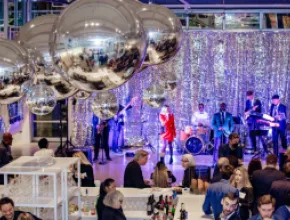Shanghai truly deserves its nickname, "Pearl of the Orient." In the middle of China's eastern coastline, the climate here is pleasant year-round and the city has managed to balance the competing needs of a vibrant cultural scene and a buzzing commercial center better than most world cities—imagine teahouses tucked between buildings that scratch the sky. On top of all of this, Shanghai is the gateway to excursions to the Yangtze River Delta, where well-heeled Chinese take their vacations.
The center of trade and finance for mainland China, Shanghai has one of the busiest ports in the world. The business travel infrastructure is well established, but that hasn't stopped new properties from sprouting up on a regular basis.
One of the newer properties is the 511-room Regent Shanghai, which boasts 17,000 square feet of meeting and event space. The 467-room Swissotel Grand Shanghai just opened its doors this month, and the 229-room PuLi Hotel and Spa, described by its managers as a “luxury urban resort,” is on schedule to open mid-year.
When it comes to convention centers, planners are spoiled for choice. There's a whopping six convention centers here, including Shanghaimart, China's first and Asia's largest permanent international trade mart. The Shanghai New International Expo Center, one of the country's leading expo centers, is in the recently beautified Pudong District.
Shanghai has two international airports: Pudong International Airport and Hongqiao International Airport. Both air hubs see numerous daily flights from both coasts of the U.S. All told, 40 Chinese and foreign air companies operate 300-plus air routes from Shanghai. In late January, Hong Kong Express Airways won approval for new routes linking Hong Kong, Shanghai and Beijing--the three shining stars in China's economic renaissance.
The trip from Pudong airport to the Pudong business district only takes seven minutes on the first commercial magnetic-levitation train line in the world; during the short trip, the train reaches speeds of 270 mph.
Once in Shanghai proper, those so inclined can shop 'til they drop in any number of areas that specialize in everything from high-fashion to folk handicrafts. For foodies, there are more than 1,000 restaurants serving the 16 different styles of food in China, including Beijing, Sichuan, Guangdong, Yangzhou, Fujian, and other local flavors. Western restaurants span the range, serving French, Russian, Italian, English, German, Japanese, and Indian food.
After a meeting, attendees can take a leisurely walk along the Pudong Riverside Promenade from Dongchang Road Wharf in the south to Taitongzhan Wharf in the north. Visitors shouldn't miss Century Boulevard, which runs three miles from the Oriental Pearl TV Tower to the Pudong Administrative and Cultural Center. Here, urban hikers can visit eight Chinese botanical gardens, including the Willow Garden, the Cherry Garden and the Yulan Magnolia Garden.
Although well known by those who do business in China, in a few short years Shanghai will get the star treatment that China's capital is expecting during this summer's Olympic Games. In 2010, Shanghai will host the Shanghai World Expo-- organizers describe it as a non-commercialized "economic Olympics." World Expos, better known as World Fairs, have been showing off the latest in architecture and technology for the last 150 years. The Eiffel Tower in Paris is probably the most famous exhibit to ever come out of a World Fair.
We're fairly certain that Shanghai won't disappoint when it gets the spotlight in a few short years. In the meantime, it's hard to beat the Pearl of the Orient as a first-class business destination with all the amenities, food and culture the savvy business traveler and meeting attendee expect from a world city.





